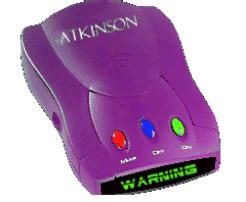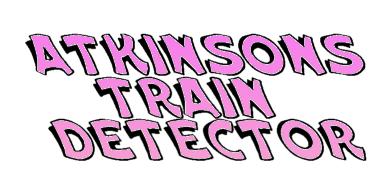

![]()

As you know, countless individuals loose their lives every year due to their inability to detect the presence of an iron behemoth crossing their path on the road ahead. The good news is that according to a Hartford City New Times Article, on 08/15/2000, one Hoosier native has finally come up with a brilliant solution that may cut those accidents drastically. The idea is to alert drivers of an approaching train right from inside of their own vehicle. This device works by receiving signals already being transmitted by nearly every single train in commission. There is no need for special transmitters and anyone can pick up the signal regardless of their proximity to a crossing point.
Many variations of an onboard train detector are currently being looked at. Most are well intentioned, but not very practical. The idea of placing transmitters at every crossing in the US is not at all likely. The cost is so high that only a few specific metropolitan areas receive this type of protection. Because Atkinson's Train Detector detects the train and not the crossing, you don't have to be in any specific area, in a vehicle or anywhere near a crossing to be warned of a nearby train. This device is so simple it can be carried on a person to ensure that a train doesn't sneak up on you if you must be on or near a track.
To understand, you must first realize that most trains are transmitting signals at regular intervals that are used in vital train functions. Atkinson's Train Detector receives the signals and alert the driver of the approaching train. In poor weather conditions, at night or at unmarked crossings, an on-board warning might be all that is needed to save a life. It could also be useful to police and other emergency vehicles. An extra layer of warning for school bus drivers would be comforting as well. Atkinson's Train Detector is really nothing more than a simple radio receiver, so it can be sold inexpensively.
Because the EOT transmitters have an important job to do, the FCC did not just pull a frequency out of a hat. Careful consideration was taken to ensure interference would not likely happen. The transmitters are more than powerful enough to reach the receiver on the front of even the longest trains, no matter what the geological conditions. Because they are located at the back and transmit towards the front, the ideal detection area is from a side approach. In a rural area, the side approach to a train can be the most deadly of all, especially at night. With out flashing lights to warn you, your eyes only see a flat black train against a flat black background. In a rural area with many unprotected crossings, Atkinson's Train Detector can be quite effective. It is certain that if you're close enough to a train that you need to detect it, the transmitting signal strength will be overwhelming.
It seems like a simple and effective way to reduce accidents by increasing driver awareness. However, the man with this ingenious invention, Denny Atkinson of Montpelier Indiana, says the railroad companies were less than enthusiastic about it when he approached them. One would think they would want to do every thing they could to see that his idea succeeds. Railroad companies should be strongly encouraged, if not obligated by law, to endorse such an idea. Transmitting a signal that I can detect in my car for the purpose of warning me that they are near is the very least they could do. After all, I'm not just crossing their tracks; they're also crossing my road.
You are 30 times more likely to die in a crash with a train than with another motor vehicle. A derailment could result and if a freight train is involved, there is a possibility that hazardous material being transported by the train could become involved and endanger an entire community. When a train and car collide, the law is on the side of the train. The car is destroyed and everyone inside is likely killed. If they are lucky enough to survive they are charged with trespassing. As far as the Railroad companies are concerned, train /auto collisions are always the fault of the car driver for being unaware.
The Railroad companies will assert that there are already existing warning devices, such as crossing lights and train whistles. The problem with the existing warning devices is that they are "last minute warning" devices. You are not aware of them until the train is already upon you. Last minute warnings are often ineffective and tragedy results. Atkinson's Train Detector provides "Early Warning" security. You are alerted to a nearby train long before you actually see or hear it, giving you maximum reaction time. Once you are warned that a train is nearby, you can then expect to see the flashing lights on the road ahead.
Atkinson's Train Detector can't promise to build an invisible shield around you. All it can do is warn you that a train is near, and caution should be taken. It doesn't matter that you've been warned of a nearby train and your not approaching the crossing immediately. The point is that you've been warned with plenty of time to react properly when you do approach the crossing. That is what this device does so well. Atkinson's Train Detector is intended to be an enhancement to existing warning systems; it is not intended to replace them. It can be thought of as a "Warning Systems Upgrade".
According to the National Transportation Safety Board, driver error was cited as the primary cause in 49 of the 60 accident cases they studied. A major factor in the cause of those accidents was driver disregard for the stop sign in 13 cases and the driver's failure to look for a train in 16 cases. Other statistics indicate that in about 25 percent of all grade crossing accidents, the car hits the train, which is already passing through the crossing. Nearly two-thirds of all crossing accidents occur during daylight hours. Because two-thirds of all accidents occur at crossings equipped with automatic warning devices, driver inattention is clearly the major cause. Not a single one of us can be sure that we don't have a date with a train in the future.
Because the transmissions are only being made from most, and not ALL trains in commission, the idea is still not as effective as it could be. If the railroad companies were to endorse this mission by voluntarily installing the EOT devices at the back of all trains, this safety device could be most effective nearly one hundred percent of the time. This could be easily accomplished with inexpensive integrated electronic circuitry. Far less costly than a single life.
Itís a dark, stormy night in Anytown, USA. A woman and her children are headed home from shopping at the grocery store. Pretty soon the rain begins to fall, and the wind picks up. The commotion outside, the screeching wiper blades and the fussy children in the back have distracted the woman. She has forgotten all about the poorly marked crossing on the road ahead. In fact it has completely slipped her mind. She is totally unaware that speeding through the crossing ahead of her and her family is a twelve million pound freight train. The woman has no idea that in moments, she and her children may suffer a terribly gruesome fate. But she could be warned of the eminent danger, because floating all around her head are invisible warnings in the form of radio waves. The train thatís headed for an interception with the unsuspecting family is transmitting that warning beacon, because that particular train is equipped with an EOT. But sadly, the warning signals canít communicate with the woman. They donít have an interface such as a train detector to communicate through, so she continues on completely unaware.
Because eighty percent of all crossings in the US are with out any warning device what so ever, it is relatively certain that an on-board warning device would help save lives if given a chance. Won't you please do what you can to encourage the Railroad companies and Congress to get behind this idea and insure its success? Such a simple and potential lifesaving concept shouldn't remain overlooked any longer.
![]() "I guarantee this device will detect most trains in most situations. I also
guarantee that this device will not detect all trains in all situations."
"I guarantee this device will detect most trains in most situations. I also
guarantee that this device will not detect all trains in all situations."
Outside the VHF band, the railroads of North America use the frequency 457.9375 megahertz for transmissions from a train's end-of-train (EOT) device to the train's lead locomotive. Most U. S. end-of-train devices transmit only. Use of two-way end-of-train devices is gaining popularity in the United States. Before the universal adoption of these EOT frequencies by the AAR, Norfolk Southern adopted its own EOT devices, which transmit on the frequency 161.115 megahertz.
On July 1, 1997, the Two-Way-End-of-Train Telemetry Devise, Final Rule, 49 CFR 232.21-232.25 became effective. Any time a train is in moving it must be in use. Furthermore, the regulatory provisions related to Two-way EOT's are intended to ensure that trains operating at a speed over 30 mph or in heavy grade territory are equipped with the technology to effectuate an emergency application of the airbrakes starting from the front and rear of the train.
| You are visitor number
|
 |
|
|||||||||||
Fatality Analysis Reporting System
Federal Railroad Administration
Railroad Safety Advisory Committee
Association of American Railroads
Kansas City SouthernRailway System Suppliers, Inc.
|
